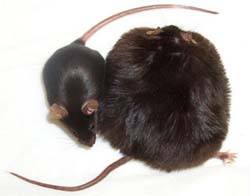[ Winter 2011]
If we can’t stop Americans from getting heavier, can we at least develop drugs that prevent them from getting sick with obesity-related diseases?
The research career of Gökhan Hotamisligil, chair of the Harvard School of Public Health Department of Molecular Metabolism, has circled around that question for more than two decades. Today, with findings from his lab poised to be translated into new drugs, the goal of averting long-term medical complications in an increasingly overweight population may be closer than ever.
Since arriving at the School in 1995, Hotamisligil has pursued with Captain Ahab–like intensity one of the most important biomedical problems of our time: the spiraling epidemic of “metabolic” diseases, such as type 2 diabetes and heart disease, associated with the relentless rise of obesity in America and, increasingly, around the world.
In October, his 2006 article in Nature, “Inflammation and Metabolic Disorders,” was named the most-cited paper in clinical medicine research. Hotamisligil has “catalyzed a paradigm shift in our understanding of the nature of metabolic disease,” said the International Association for the Study of Obesity, which named him the 2010 winner of its prestigious Wertheimer Award, given every four years for outstanding basic science contributions to the field.
RACING AGAINST A SURGING EPIDEMIC
When Hotamisligil launched his research here 15 years ago, the U.S. rate of overweight and obesity was already 56 percent; in lock step, the prevalence of diabetes was surging. Today, the overweight rate is 66 percent, and the paired epidemics are rising so rapidly that, if current trends continue, by 2015, a shocking three of every four Americans will be overweight (and 41 percent obese) while 15 percent of adults will be living with diabetes and its often-devastating complications. (Normal weight is a body mass index—BMI—of under 25; overweight is 25 to 29.9, and a BMI exceeding 30 is considered obese. Obesity is also associated with a disproportionate amount of body fat.)*
Given the lack of success in curbing obesity, a bigger public health payoff may come in finding better ways to blunt the body’s many harmful responses to excess weight. That means gaining a much more detailed understanding of the underlying pathology of chronic metabolic illnesses.
At HSPH, Hotamisligil has doggedly hunted the complex and elusive biological links between obesity and insulin resistance—the first stage in developing metabolic illness. He has uncovered new molecular pathways and identified control points that may prove to be valuable targets for short-circuiting the connection between obesity and poor health.
A NEW PICTURE OF THE BODY
Over the years, Hotamisligil has expanded his investigations of the mechanisms behind inflammation—the body’s complex biological response to injury, infection, and to the cellular stress caused by obesity. He has also delved into the role of lipid-binding proteins. Most recently, Hotamisligil has woven these discoveries into a cohesive new picture of how the body normally maintains a healthy energy balance—and how so many bad things happen when the metabolic machinery becomes overwhelmed by excess nutrients and fat and starts to break down.
In his view, the metabolic balance of fuel and energy in the body is regulated by two systems that have been intertwined through evolution. One is made up of networks of proteins that sense levels of nutrients and adjust their processing into energy; the other is the immune system cells that detect microbes and fight them off. This integration of the two systems, according to Hotamisligil, accounts for the inflammatory response to overweight and obesity, although this particular form of inflammation—he calls it “metaflammation”—is not the result of infection and does not resemble the classic features of inflammation at all.

THE PATH FROM OBESITY TO DISEASE
In a recent interview, Hotamisligil reflected on the trajectory and implications of his prolific research. His spacious office is artistically decorated and obsessively neat, with piles of manuscripts and journals squared up perfectly at attention. A native of Turkey, he is, not surprisingly, a lover of strong coffee, and although it’s late in the afternoon, he produces cups of espresso for himself and a visitor. “From the beginning,” he explains, “The big question for me was why, in the presence of even a few extra pounds of accumulated fat, do you become prone to so many different diseases, including insulin resistance, diabetes, hypertension, asthma, neurodegenerative diseases, and cancer?” He likens this condition to an accelerated form of aging of the body.
The general idea is that when individuals gain and retain excess pounds, dietary fats are no longer safely stored in cells called adipocytes. As a result, lipids—blood-borne fats—spill into the circulation and deposit themselves in skeletal muscles, the liver, the heart, and blood vessels. There, through biochemical actions, the lipids throw a wrench into the normal uptake of glucose into muscle and other body cells by making the cells’ receptors “deaf” to insulin signals. Insulin resistance creates a pre-diabetic state of rising blood sugar levels, triggering a cascade of tissue-damaging events.
Hotamisligil and other scientists had discovered that adipocytes are not simply passive fat-storing cells; they also emit metabolic and hormonal signals, some of which help regulate the immune system. During his earliest work at the School, he attracted attention with a finding that when he knocked out one of these immune-activating signals in obese mice, they were less prone to the ill effects of excess weight, providing solid evidence that erroneous immune response is triggered by excess nutrients and energy.
He later showed that mice lacking a particular fatty acid binding protein (FABP) didn’t develop insulin resistance even when eating a high-fat diet. These escort proteins or “lipid chaperones” latch onto fat molecules and transport them within cells and dictate their biological effects. Hotamisligil reported that when these FABP-deficient mice were fed on high-fat diets, they were protected from diabetes, fatty liver, and heart disease.
Obesity: A global snapshot
|
|
|
|
|
|
Sources: World Health Organization; Medicine & Science in Sports & Exercise, October 2010; Organization for Economic Cooperation and Development |
CONVINCING THE SKEPTICS
These and other early discoveries began to implicate immune system overreaction and inflammation as triggers of metabolic disease. But the upstart ideas ruffled some feathers in the mainstream obesity community. “Many people were not convinced,” he says, referring to the early ’90s.
Thus, Hotamisligil was gratified when he won the 2007 Outstanding Scientific Accomplishment Award of the American Diabetes Association for discovering the inflammatory basis of obesity and Type 2 diabetes. The award recognizes “independence of thought, originality, significance of discovery, and impact on his/her area of research.”
Many more findings on this theme were to follow, and not just in mice. In 2006, Hotamisligil and HSPH Associate Professor Eric Rimm reported that obese individuals who had inherited another variation of a fatty acid binding protein gene were much less prone to Type 2 diabetes, heart disease, and elevated triglycerides. In 2008, it was reported that blocking an inflammatory cytokine in humans treats insulin resistance and Type 2 diabetes.
And in 2010, scientists at Harvard-affiliated Joslin Diabetes Center reported that an aspirin-like drug improved insulin function and other complications in diabetic patients, raising the prospect of treating diabetes with off-the-shelf anti-inflammatory drugs.
NEXT: DRUG TREATMENTS
Although there is still much more to be unraveled, Hotamisligil’s discoveries have already produced a number of targets within the obesity-triggered networks that drug-makers have in their sights. Some potential drugs would hinder the action of fatty acid binding proteins; others would inhibit molecular signals that rev up inflammation in response to cellular stress caused by overburdened fat cells. This type of stress affects the “minifactories” called endoplasmic reticulum within cells where proteins are made. In his most recent work, Hotamisligil is developing strategies to beef up the minifactories’ ability to absorb the extra demands of obesity without sounding an inflammatory alarm. A prototype medicine to fix the problem in endoplasmic reticulum and reduce its stress also works in humans, as shown by collaborative work published this year with Professor Samuel Klein at Washington University in St. Louis. Now the hunt is on for new and more powerful molecules to replicate these early findings.
None of the newly developing compounds has yet reached clinical trials, but may in the next few years, Hotamisligil says. Another strategy that may bear fruit sooner involves hormones—which he calls “lipokines”—that Hotamisligil has identified in mice that halt or even reverse insulin resistance and other complications related to obesity and Type 2 diabetes. One such lipokine is a rare nutrient in nuts and other foods called palmetoleate. Because it is a natural substance without known adverse effects, he says that if funding can be obtained, a clinical trial could happen “at any moment.” In collaboration with HSPH Professor Dariush Mozaffarian, recent work showed that people with high levels of this lipokine have marked protection against Type 2 diabetes.
Obviously these efforts to combat obesity-related diseases are very early and the outlook uncertain. Yet the groundwork being laid by Hotamisligil and others in the field is promising, and the potential for reducing the insidious and extraordinarily worrying toll of obesity is enormous.
“Ten years from now, I hope that there will be drugs on the shelves emerging from this research—not necessarily from what we are doing, but related to it,” he says. “I predict that such drugs will not be toxic to the heart and have other bad side effects, which current diabetes medications do. I also hope that at least some of these drugs will be affordable and reach the mass populations with desperate needs.” Looking farther ahead, Hotamisligil, who calls himself “pathologically optimistic,” sees a future in which the food industry can tinker with thousands of individual nutrients in foods to enhance their healthful properties. “That,” he says, “is the next frontier.”
Richard Saltus has written about science, medicine, and public health for the Associated Press, the Boston Globe, the San Francisco Examiner, and The New York Times.
*Body mass index is a measure of body fat based on height and weight in adults. Compute your BMI.
